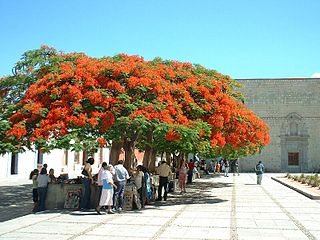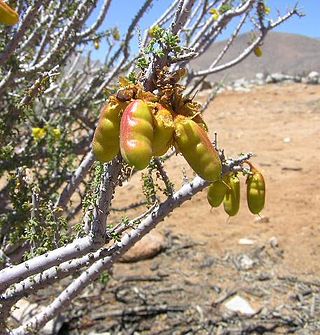
The Mimosoideae are a traditional subfamily of trees, herbs, lianas, and shrubs in the pea family (Fabaceae) that mostly grow in tropical and subtropical climates. They are typically characterized by having radially symmetric flowers, with petals that are twice divided (valvate) in bud and with numerous showy, prominent stamens.

The Faboideae are a subfamily of the flowering plant family Fabaceae or Leguminosae. An acceptable alternative name for the subfamily is Papilionoideae, or Papilionaceae when this group of plants is treated as a family.

Caesalpinioideae is a botanical name at the rank of subfamily, placed in the large family Fabaceae or Leguminosae. Its name is formed from the generic name Caesalpinia. It is known also as the peacock flower subfamily. The Caesalpinioideae are mainly trees distributed in the moist tropics, but include such temperate species as the honeylocust and Kentucky coffeetree. It has the following clade-based definition:
The most inclusive crown clade containing Arcoa gonavensisUrb. and Mimosa pudicaL., but not Bobgunnia fistuloides(Harms) J. H. Kirkbr. & Wiersema, Duparquetia orchidaceaBaill., or Poeppigia proceraC.Presl

The subfamily Detarioideae is one of the subdivisions of the plant family Fabaceae (legumes). This subfamily includes many tropical trees, some of which are used for timber or have ecological importance. The subfamily consists of 84 genera, most of which are native to Africa and Asia. Pride of Burma and tamarind are two of the most notable species in Detarioideae. It has the following clade-based definition:
The most inclusive crown clade containing Goniorrhachis marginataTaub. and Aphanocalyx cynometroidesOliv., but not Cercis canadensisL., Duparquetia orchidaceaBaill., or Bobgunnia fistuloides(Harms) J. H. Kirkbr. & Wiersema.
Stuhlmannia moavi is a species of flowering plants in the legume family, Fabaceae, and the only species in the genus Stuhlmannia. It belongs to the subfamily Caesalpinioideae. It is native to Kenya, Tanzania, and Madagascar.

Balsamocarpon brevifolium, or algarrobilla, is a species of flowering plants in the legume family, Fabaceae. It is the sole species in genus Balsamocarpon. Balsamocarpon belongs to the subfamily Caesalpinioideae and tribe Caesalpinieae. It is endemic to northern and north-central Chile.
Lophocarpinia aculeatifolia is a species of flowering plants in the legume family, Fabaceae. It is the sole species in genus Lophocarpinia. It is a tree native to Paraguay and northern Argentina. It belongs to tribe Caesalpinieae of subfamily Caesalpinioideae.
Pomaria is a genus of flowering plants in the legume family, Fabaceae. It belongs to the subfamily Caesalpinioideae.
Stenodrepanum bergii is a species of flowering plants in the legume family, Fabaceae. It belongs to the subfamily Caesalpinioideae. It is native to Argentina.
Petaladenium urceoliferum is a species of flowering plant in the family Fabaceae. It belongs to the subfamily Faboideae. It is the only member of the genus Petaladenium. It produces three chemical compounds in its leaves that are not found in other members of the Amburaneae: (2S,4S,5R)-5-hydroxy-4-methoxypipecolic acid, (2S,4R,5S)-5-hydroxy-4-methoxypipecolic acid, and (2S,4R,5R)-4-hydroxy-5-methoxypipecolic acid. Petaladenium urceoliferum is unique among legumes in having fimbriate–glandular wing petals.

The tribe Dalbergieae is an early-branching clade within the flowering plant subfamily Faboideae. Within that subfamily, it belongs to an unranked clade called the dalbergioids. It was recently revised to include many genera formerly placed in tribes Adesmieae and Aeschynomeneae and to be included in a monophyletic group informally known as the dalbergioids sensu lato. The members of this tribe have a distinctive root nodule morphology, often referred to as an "aeschynomenoid" or "dalbergioid" nodule.

The tribe Caesalpinieae is one of the subdivisions of the plant family Fabaceae: subfamily Caesalpinioideae.

Guilandina is a genus of flowering plants in the legume family, Fabaceae. It belongs to the subfamily Caesalpinioideae and tribe Caesalpinieae.
Coulteria is a genus of flowering plants in the legume family, Fabaceae. It belongs to the subfamily Caesalpinioideae. It includes ten species native the tropical Americas, from northern Mexico through Central America to Colombia and Venzezuela, including Cuba and Jamaica.

Tara is a genus of flowering plants in the legume family, Fabaceae. It belongs to the subfamily Caesalpinioideae.
Arquita is a genus of flowering plants in the family Fabaceae. It belongs to the subfamily Caesalpinioideae. It includes five species, which range from Ecuador to northern Argentina.
Biancaea is a genus of flowering plants in the family Fabaceae. It includes seven species, which range from Yemen to south Asia, Indochina, Malesia, China, Korea, and Japan. It belongs to the subfamily Caesalpinioideae and the tribe Caesalpinieae.
Denisophytum is a genus of flowering plants in the family Fabaceae. It belongs to subfamily Caesalpinioideae and tribe Caesalpinieae. It includes eight species, which have a disjunct distribution – northern Mexico, Florida and the Caribbean, southern South America, the Horn of Africa, the Arabian Peninsula, and Madagascar.
Hererolandia pearsonii is a species of flowering plants in the family Fabaceae. It is the sole species in genus Hererolandia. It is a shrub endemic to Namibia where it grows in Karroo-Namib shrubland. It belongs to tribe Caesalpinieae of subfamily Caesalpinioideae.
Afrocalliandra is a genus of flowering plants in the family Fabaceae. It belongs to the mimosoid clade of the subfamily Caesalpinioideae. It includes two species, both native to sub-Saharan Africa:









